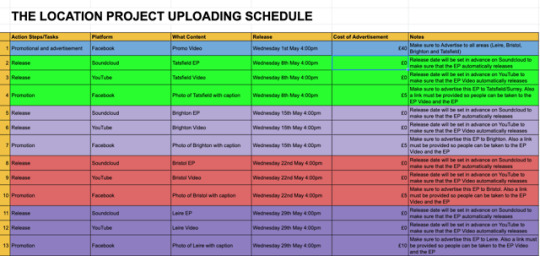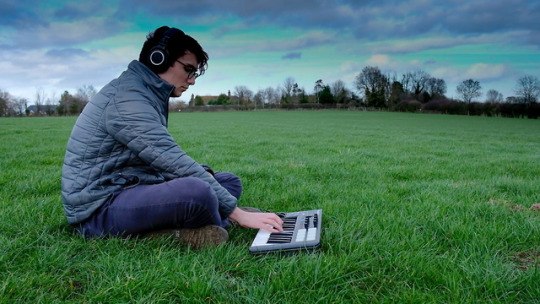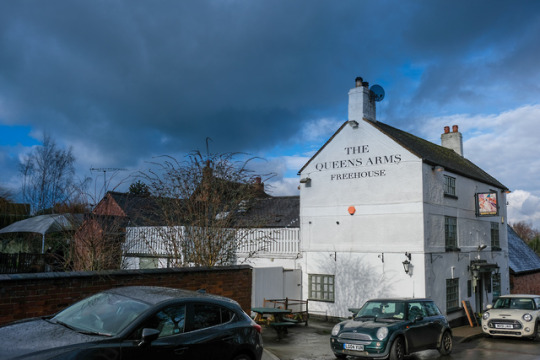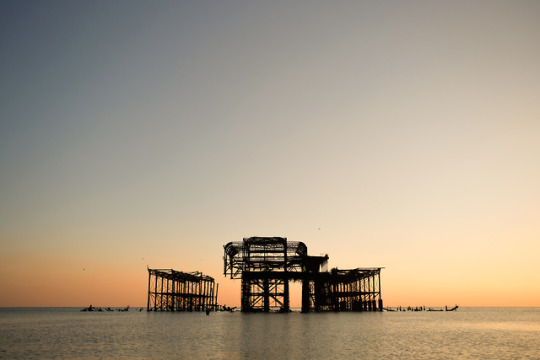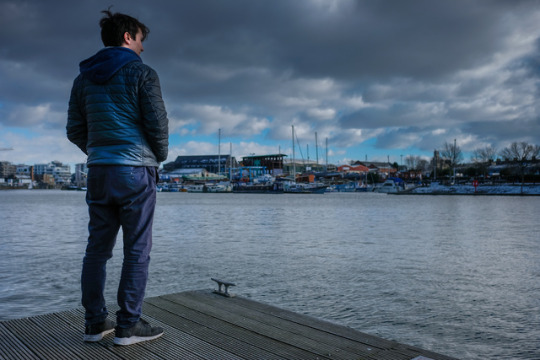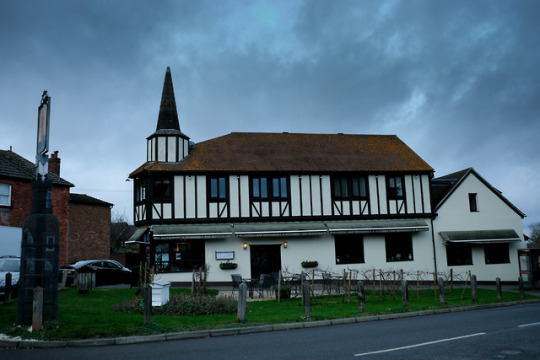This project aims to explore whether personal environments influence the music an artist creates. The Location Project will be made up of four experimental EPs and each EP will contain three tracks. Each EP will represent a meaningful location to the artist and each of the three tracks will represent an area of significance to the musician within that location. Each track within each EP will reflect the artists emotions and feelings about this area. Four videos (one for each location/EP) will be provided to help capture the process of the track creation whilst providing information about each area of significance. The videos will be uploaded to YouTube and the four EPs will be released on Soundcloud under the alias ‘The Location Project’. In context of this assignment, ‘the artist’ refers to myself, Tobias Crane.
Don't wanna be here? Send us removal request.
Text
Social Media Update: 09/05/19
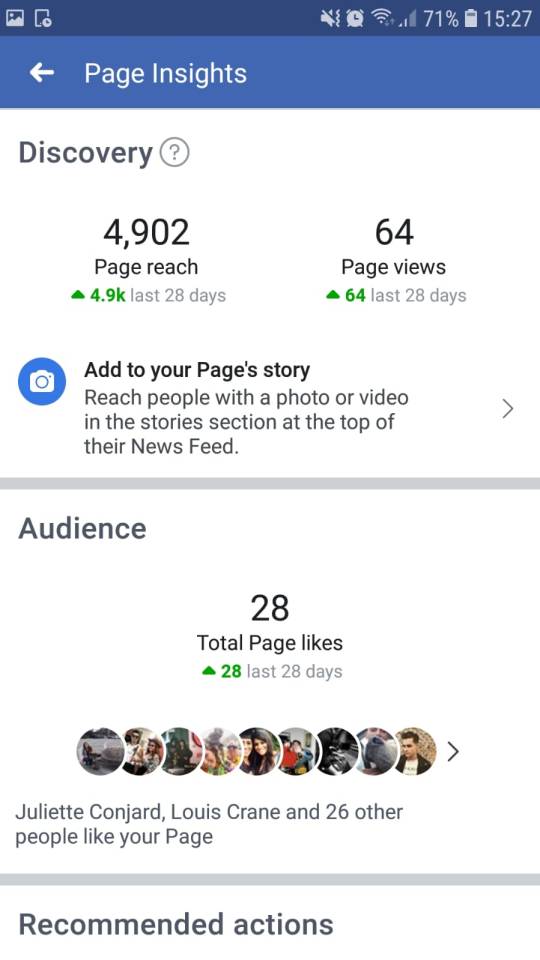
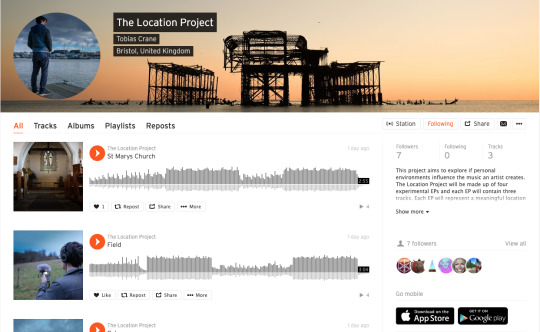

Facebook:
Within the first week of promotion I have 28 followers, and because of my promotion, my posts have reached 4.9k people. I am extremely pleased with this as my promotion has not finished yet. At this rate, my Facebook page could grow to a great size in the coming weeks.
YouTube:
Unfortunately, I do not have any subscribers on YouTube yet, but this is expected within the first week. I hope with the upcoming uploads and promotion I can get more subscribers.
Soundcloud:
I have 7 followers in 8 days, almost a follower a day. This is a steady growth, I hope to see more followers by next week when the next EP and video comes out.
0 notes
Photo
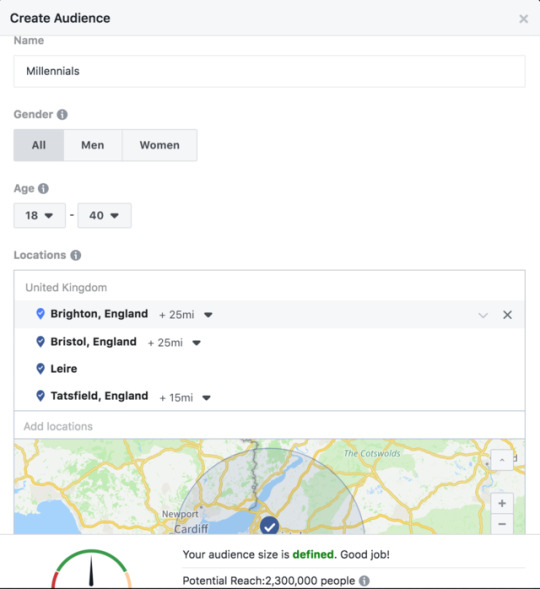
Proof of Payment. The promo video will be advertised to the locals within these four locations.
0 notes
Text
Uploading schedule, 27th April:
Within the Bristol EP and Promotional video blog posts, I mentioned something about an uploading schedule as I do not want to release all of this content at once. My reasons for doing this is because I personally feel that it is unprofessional to just naively place all of this hard work on social media and streaming platforms just because it is finished. This content needs to be advertised correctly, especially if I plan to do more of this type of music work in the future.
Therefore I have created a timeline of what I want to release, when I want to release it, which platforms I want to release a particular type of media too and any notes I may have about how I go about uploading all of this content.
I am fully aware that this will mean that I will finish uploading all of this work after the module deadline but I plan on handing in all of this project’s content into Google Classroom.
The next post will be proof of paid advertisement for the promotional video that will be released on the 1st of May at 4:00pm.
Below is a copy of the uploading schedule:
LINK TO FACEBOOK PAGE:
https://www.facebook.com/thelocationproject/?modal=admin_todo_tour
LINK TO YOUTUBE:
https://www.youtube.com/channel/UCBLtQegCPfUNCUuvGxIWBVA
LINK TO SOUNDCLOUD:
https://soundcloud.com/thelocationproject
0 notes
Text
Digital Platforms for Distribution and Promotion, 17th April:
After speaking with my peers at university and my family, I have decided how I will broadcast each EP and who my target audience are. I will be using Facebook for advertising, YouTube to upload the videos and Soundcloud to broadcast my music. Using these three platforms allows me to cover all bases in terms of advertisements and promotion (Facebook) and distribution of music and video (Soundcloud and YouTube). Facebook was chosen due to its ability to target a certain set of people in an area to advertise to, YouTube was selected as it is the biggest broadcaster for video in the world and Soundcloud was chosen due to its simple interface and anyone can listen to each EP, they do not have to sign up to use it like Spotify.
One major issue within my written proposal last semester was that I didn't really have a target audience. After discussing this problem with my peers at university, we decided that maybe it is the locals within each of these locations that might want to engage with this content. This is because some locals may feel passionate about where they live. Therefore, they might be interested to see how that area makes an outsider feel. Therefore, with my target audience in mind I will be applying my Facebook advertising in Leire, Brighton, Tatsfield and Bristol.
0 notes
Text
Promotional/EP videos and EP/Track cover Photos, 12th - 14th April:
Completing the videos this weekend took a very long time. I underestimated the amount of hard work that into them. However, by the end of the weekend the videographer and I got all four EP videos completed, plus, a 2:30 minute promotional video that advertises what the project is about and what is to come (the 4 EP videos). Plus, the photographs that Alex had edited were sent to my dropbox just in time before the videographer arrived.
The weekend started off quite slow as we did not know what the timeline of each video should be and what should be included. All we knew is that we wanted each video to be roughly 10 minutes in length and each video would discuss the ideas and processes around each EP.
In the end we were inspired by the video style of Martin Garrix when he was making his ‘Animals’ track. The video showed him in his studio with a camera crew as he talked through how he made each section of this track and the ideas behind each section (Future Music Magazine, 2014). Therefore, following Martin Garrix’s camera set up, James set up his camera facing me and the computer so I could talk to the camera whilst also addressing my work at the same time.
However, when listening back to my talk through of each track, they were too long to fit into 10 minutes. In the end, instead of going into a lot of detail about the sound design and composition of each track (like I originally wanted), I had to briefly explain the composition and the concept of each track in the EP. Although, even when doing this, each video still ended up to be roughly 15-20 minutes in length!
Each of the four EP videos are split into three sections (one section for each track) and each section has a very similar lay out:
Each section starts with the audio of the track in question coming through. Whilst the track is playing, video clips of the recording/melody process would play.
The video clips would then fade out to me talking about that track and roughly how it was made and the ideas behind it
After talking about the composition, my feelings and the concept behind the track, the video would then fade and play the next track in the EP.
All of the above was done three times in total as there are three songs in each EP, therefore three sections to each video.
This timeline was selected in the end as it was simple to construct whilst also looking professional.
The promotional video starts with me discussing what's to come in the next four videos whilst also explaining the aims and purposes of this project. The video finishes with video clips taken from each location of me recording/creating melodies in each area. The track that plays in the background is The Queens Arms, Leire. This is because it is the most epic sounding song out of all the tracks that have been created in this project and it sounded really good on the promotional video.
When I received the manipulated photographs Alex sent me I was extremely pleased with the result. The photographs full-filled my brief and they looked great! They were high quality, edgy looking and (in my opinion) looked professional.
Having completed all of the songs for each EP and the videos puts me in a great position as this whole project is now complete. The next step is to create an uploading schedule and different digital profiles where I will be able to distribute and promote my work successfully. I will organise a meeting with my family and my peers at university on what they think is the best approach to do this as I do not have much knowledge in this field (promotion and broadcasting). I understand that selecting a broadcasting/promotional platform(s) is a big decision to make so getting advice here is of crucial importance.
Below is the Promotional Video (I do not want to release the EP videos yet, I will hand in all of the EP videos to Google Classroom) and five of my favourite photographs Alex manipulated:
References:
Future Music Magazine (2014). Martin Garrix In The Studio With Future Music. [video] Available at: https://www.youtube.com/watch?v=CfCmoEixxro&t=43s [Accessed 25 Apr. 2019].
0 notes
Video
tumblr
Promotional Video for ‘The Location Project’.
0 notes
Text
Mastering - 5th - 6th April
Mastering is the last stage within the music production process before a track is then distributed (Izotope.com, 2014). The main aim of the mastering engineer is to take a track and make small tweaks to make it sound better and a little louder. The mastering engineer then prepares the track to be distributed for the correct audio platform as discussed with the client (online, CD, Vinyl). A basic mastering chain often includes, EQ, compression and limiting (Izotope.com, 2014).
For my project, the music I have made has been mastered for music streaming platforms as that is how I plan to distribute this content. Therefore my main aim as a mastering engineer was to generate loud, top quality audio to compete with the loudness of some of the other tracks that are on these platforms (ArtistsHouseMusic, 2010). However, I did not want to distort the audio within these EPs. Therefore when a track started to distort due to increased gain from the limiter I would stop and then mastered each track within each EP to match that track. This was done in order to have equal loudness throughout each EP and to minimise track distortion.
I was inspired by Ian Shepherd when constructing my mastering chain as I used the same order of plugins he uses to master his tracks. My mastering chain was, Gain (if needed), EQ (Fab Filter - Pro Q2), Compression (Fab Filter Pro - C2) then Limiting (Fab Filter Pro - L2) (Production Advice, 2014). At the end of the mastering chain I used a loudness meter to help me gage the overall loudness of each track before and after the mastering process. I constantly made sure to A-B the mastered track with the unmastered track to judge if my mastered version did sound better.
Arguably one of the main requirements of any mastering studio is the monitors. According to Bob Katz “the mastering engineer's monitor system is an audio microscope” (Katz, 2002). The monitors I used were the Neumann KH130s which are especially flat and ideal for mastering (Robjohns, 2013).
Overall I am very happy with what each EP sounded like, I added a suitable amount of gain to the unmastered versions, whilst adjusting some slightly resonant frequencies. My next step is to wait for my videographer to get to Bristol and the photographer to send over the edited photos so we can start constructing the videos.
References:
ArtistsHouseMusic (2010). Mastering Engineer Greg Calbi on Compression and the Loudness War in Mastering [video] Available at: https://www.youtube.com/watch?v=Do1FJ5BcqSY [Accessed 6 May 2018].
Izotope.com. (2014). What is Mastering? Why Is It Important? | Audio Mastering. [online] Available at: https://www.izotope.com/en/blog/mastering/what-is-mastering.html [Accessed 5 May 2018].
Katz, R. (2002). Mastering Audio: the art and the science. Boston: Focal Press, pp.75-87.
Production Advice (2014). Loudness War Myths - 1: Louder sounds better. [video] Available at: https://www.youtube.com/watch?v=ng_gOHRl-r0&t=528s [Accessed 6 May 2018].
Robjohns, H. (2013). Neumann KH310A. [online] Soundonsound.com. Available at: https://www.soundonsound.com/reviews/neumann-kh310a [Accessed 25 Apr. 2019].
0 notes
Text
EP Covers and Video - 4th April
Since finishing the Leire EP I have contacted my videographer so we can edit/finish the videos. He is coming up to Bristol on 12th of April until the 14th of April to help me complete the videos. I now have to finish mastering each EP before he arrives so we can easily map the audio to the visuals.
James (my videographer) has also put me in contact with his colleague Alex (photographer) as I need the pictures James took of me and the locations to be manipulated so I can use them for EP covers/ promotional photos and also use them within the videos. Alex agreed that he would be able to edit 12 photos (one photo for each song) by the time James and I would meet to finish the videos. I did not give Alex much of a brief on how I wanted the photos to look, I just said that I wanted the photos to look a bit more ‘edgy’ and ‘professional looking’ but still in keeping with the natural organic look of the original photographs that were taken. I felt that it was important to keep the EP/track cover photos looking natural because all of my songs are organic as they are using raw and manipulated recordings of each area. Therefore I felt that it would not make much sense having crazy looking EP covers as that would not suit the music.
Having photos/EP covers was something I had completely forgotten about until now as I have been so immersed in music creation. I have been very lucky that I have been able to find Alex through James and that he is available for work. In the future I need to be conscious of the whole project, not just the music bits.
0 notes
Text
Leire EP - 2nd - 4th April
St. Peter’s Church, Leire:
This church is very significant and special to my family as my parents and grandparents got married in this church. However, I myself do not have many memories of it. I know I went there as a child but when I visited it, I did not have much of an impression of it. Therefore I decided that the composition should utilise the sounds of the church as much as possible rather than try and make up emotions to help shape the composition. The result was amazing, I used every sound of the church I could possibly find within my raw recordings. I also used some of the manipulated sounds of the church, especially the heating reader clock.
The track begins with the doors of the church opening into the wildlife outside. I thought that this sounded excellent as Leire is known for its wildlife, so to incorporate this into the track itself was great. The lead sound that can be heard from (0:28) is actually some sound design of the heating reader pitched up 23 semitones and sped up 500% (all done within Alchemy). This lead sounded a little like a flute and it complimented the pad sound that can be heard in the drop (at 0:48) very well. For that pad sound I actually used a pad that was crafted in the sound design process out of a field gate, I also mixed it in with some manipulated heating reader sounds (all done within Alchemy). To help tune this lead pad, I used the same technique that was used in the creation of the Tatsfield EP (using the perfect pitch of the piano to help tune the pad) (Holmgren, 2018).
In the second half of each drop (1:04 - 1:20), textures start to come through that add to the rhythm of the track. This was done to add a little bit of variation to this track and to show a little bit of the sound design. In this section of the drop you can hear the some manipulated gate/heating reader clock sounds, and the constant raw recording ticking of the heating reader clock. This clock was used in this track to give the impression of time going past.
Overall, I am very happy with how this track sounds. It is a great opener to this EP and I am pleased with the mixing process. The track sounds quite clean and rich whilst also providing a nice rhythm.
Field Leire:
When my grandparents used to live in Leire they used to own this field. I have very fond memories of this place and I really enjoyed playing in it as a child. However those times have gone now and since then my grandfather unfortunately passed away so the memories towards this place definitely feels like something of the past. This kind of emotion towards this area definitely came out of the melody that was created within this location. The composition within this track is quite slow with lots of space in the mix, this was done on purpose due to the emotional gap I was left with after my grandfather died.
The track starts with a slow moving pad that was made out of a gate constructed in the sound design phase. Then the track shifts to raw piano and a striking lead (0:45). The lead is a manipulated gate sound from the field. Other harmonics were added to this texture within Alchemy to give it that siren effect. This siren effect was created to give the track a bit of urgency and uneasiness in order to help match my emotions to this song. The pad sound within this track was actually made from a manipulated gate sound that was constructed within the sound design phase. Within Alchemy, this manipulated gate sound was put through granular synthesis, other harmonic were also added to this sound, thus creating a moody pad sound that fitted well with the lead of this track.
Within the gap of the drum beats, some textures can be heard. These textures are the heating reader clock sped up and some manipulated metallic gate sounds. I felt that these textures really added a certain crispiness to the track and gave the song a bit more of an identity.
Overall I think this track is probably mixed the best out of all 12 tracks of this project. I felt very passionate when writing this composition and I think that this has come through in the music.
The Queen’s Arms Leire:
Finally, the last track of the EP is The Queen’s Arms pub. This place is probably the most significant to me out of the whole of Leire and all the locations/areas I have been to. When my grandfather passed away, this was where his funeral was held, it was a sad but happy day. This emotion was something I wanted to try to emulate in this piece.
This track starts out very simple, soft piano and raw recordings taken of the pub garden. My grandfather loved listening to classical music and so that is why I decided to keep a lot of the raw melody that I made in the composition itself. Plus, the moving piano is supposed to emulate the sadness of when he passed. The second part of the track drastically changes from sad to uplifting (1:21). This was done on purpose as this section of the track is there to try and celebrate his life. The sound you can hear at 1:21 is a manipulation of the heating clock. This was used to signify the break between sadness and celebration. The vocal like pad is actually just a manipulated gate sound taken from the sound design phase which has been slowed down and pitched accordingly to fit with the key of the rest of the track. From 1:38 - 2:10 lots of interesting textures start to poke through the mix. You can hear raw recordings of the lock on the church door and a manipulated gate sound from the field. This was done to not only add to the rhythm of the track but also to show the influence my grandfather had over these two areas and my memories of them.
Overall I think this was the best EP of the four. I thoroughly enjoyed making each track and applying what I had learnt throughout the entirety of this project to each composition. I have finished all the EPs in good time, all I need to do now is the mastering of each EP and complete the videos.
LINK TO EP: https://soundcloud.com/thelocationproject
References:
Holmgren, M. (2018). Alchemy Sound Design Tutorial New Features Logic Pro X 10.4.2. [video] Available at: https://www.youtube.com/watch?v=luujpfn4aVE [Accessed 18 Apr. 2019].
0 notes
Text
Leire Sound Design - 1st April
As this was the last day of sound design for this project I wanted to utilise everything I had learnt over the past month about the sound design process. I have learnt that quality is definitely better than quantity and sound design is best in pad and/or quick stab like format as this can be quickly used within a composition. Plus, resampling is brilliant for getting some really interesting textures (Computer Music, 2015). A brief explanation about how each recorded sound was manipulated is listed below in this flow diagram [Original sound -> manipulation -> resulting sound]:
Field gate -> Gate, EQ, Chorus, Erosion, Vocoder. (The settings on these plug ins were tweaked to get lots of interesting textures and pads) -> glitchy metallic sounds, each with a slightly different timbre.
Gunshots from the field -> Pitched down 18 semitones and on Re-Pitch setting in Ableton. Gate, EQ,Overdrive, Ping Pong Delay, Vocoder. (The settings on these plug ins were tweaked to get lots of interesting textures and pads) - > detailed stab like sounds.
Mud squelching in field -> Pitched down 26 semitones and time stretched using Beats setting. Chorus, Overdrive, OTT, Gate, EQ, Vocoder and Reverb. Pitched up 23 semitones on Texture setting. -> Murky menacing like pad
Heating meter clock found in church -> Pitched up 26 semi tonnes on Texture setting and audio was sped up. Reverb, Vocoder, Ping Pong Delay. -> Interesting deep slurp like texture.
Interesting deep slurp like texture -> Gate, Erosion, Overdrive, Ping Pong delay, OTT, Vocoder and EQ. (The settings on these plug ins were tweaked to get lots of interesting textures and pads) -> powerful kick like texture, glitchy clock stab, deep house like stab.
Glitchy metallic sound (from field gate) -> Granulator II with Grain size at 150 Hz which was then pitched to C1 -> creating a sub bass to be used within each track of the Leire EP.
Overall I very happy with what the sound design I have produced. I can get now get started on my final EP in good time. After the creation of this EP however I will need to think about my marketing strategy and how best to promote and distribute all of this content. Plus, organise my videographer to come back up to Bristol to finish all the videos.
Below are some audio clips of before and after the sound design process took place:
References:
Computer Music. (2015). 18 expert sound design tips and tricks. [online] MusicRadar. Available at: https://www.musicradar.com/tuition/tech/18-expert-sound-design-tips-and-tricks-613516 [Accessed 18 Mar. 2019].
0 notes
Audio
Leire field gate - before and after sound design process
0 notes
Audio
Leire St. Peter’s Church Lock - before and after sound design process
0 notes
Text
Bristol EP - 28th-31st of March
Bristol Platoon:
The memories of the platoon next to the Grain Barge are quite unnerving and sad. In my first year in university I had accommodation on Hotwell Road and I hated my time there. Whenever I pass my old accommodation building I am always reminded of how far I have come since being at university and the friends I have made along the way. When I was struggling in my first year I would often sit on that platoon and try to reflect and relax. The aim of this experimental piece was to try and apply that thinking type noise that was going on in my head at the time which in turn drowned out the peacefulness of the river I was sitting next to. Overall I think this track completed this aim brilliantly as it is clear within the song that there is a battle between peace (the raw recordings of the river) and the sound of overthinking (horn noise).
The beginning of the track starts with a raw recording of water underneath the Platoon, then, a boat like horn sound is introduced, draining out the sound of the water. The horn is made out of a sub bass that was constructed within Ableton using Granulator II. The sub bass was then loaded in to Alchemy where sound was pitched, downsampled and bit-crushed. The horn lead followed the melody that was constructed when I was sitting on the platoon.
The section you can hear in the middle of the track (0:48 - 1:58) is a water pad that was constructed within the sound design phase mixed with raw recordings of footsteps on the platoon. The ticking sound from 1:24 was made out of an escalator. The purpose of this ticking sound was to emulate time going past.
Millennium Square:
Millennium Square is also a place within Bristol I mostly relate to my university first year experience. When I was living on Hotwell Road I used to have to walk through this area to get to university. I have quite mixed feelings about Millennium Square as I loved the look of it as a location but to this day I do not like what that place means to me emotionally, as I still relate it to my memories of my accommodation on Hotwell Road. Therefore, the melody creation and composition aimed to sound quite menacing whilst including a lot of the sounds you can hear from Millennium Square. In reflection, I believe that this track successfully accomplished this aim as the resulting composition sounded dark and resembled a sort of Hip Hop like beat that really added rhythm to the track. Everything within this piece was constructed out of sounds that could be heard within Millennium square.
The beginning of the track starts out with the manipulated Millennium Square TV pad sound that was constructed within the sound design phase with added distortion sounds. The reason for doing this was because it reminds me of the sounds the TV within Millennium Square emitted but as the distorted sounds are introduced, it adds an uneasy feel to the track that reflect my emotions of this area. The lead is a pitched up sub bass that follows the melody pattern (the same sub bass that was constructed in the sound design phase). The pad that sits just underneath the lead is made out of water sounds that have been pitched up 33 semitones, sped up by 300% and finally an added LFO mapped to the gain (all done within Alchemy). All the little foley sounds you can hear are made from the Millennium Square TV pad, sirens and the waterfalls from Millennium Square.
V Shed:
V Shed is a Wetherspoons pub situated on the harbour side. This area is quite special to me as I met my first friends from university there. Later that same year we all decided to live together for the duration of our time at university. Therefore, as this is a happy area with nice memories, the melody within this track is playful and happy as I purposefully selected major keys (Wmich.edu., n.d.). For this lead I just used the raw piano for the beginning of the track and then within the drop, I pushed the melody up an octave. The pad that can be heard in the drop is made out of the water pad that was constructed within the sound design phase of which an LFO was then added to the panning to make it switch from left to right (this was all done within Alchemy and the pad followed the melody pattern created within V Shed). This pad was created like this as I thought that it accompanied the lead very well and I thought that the textures/sound of the pad made the track sound more reflective.
Within the middle of the track (1:36 - 2:26) you can actually hear me talking with one of my friends about going away on holiday. This was done to help capture the memory of discussing plans with friends and having a good time.
After making this EP, I played it to my flatmates as they play a big part in my life in Bristol and I wanted to know what they thought. They told me that the sound design is incredible and they loved the flow of each track. I also played them the other two EPs and they told me that I am getting better at constructing and mixing each track as each EP is sounding better than the last. This has filled me with confidence as I now go onto creating my last EP.
Overall I really enjoyed making this EP, I think that each composition has captured my feelings of each location and each track is unique whilst also remaining quite personal to me. Having completed this EP just before April puts me in good stead for the rest of this project. If I keep pushing EPs out as fast as I have made this one I should be able to finish on time. However, I am becoming increasingly self conscious that even though I may finish this project in time, I may not be able to upload all of the content in the time frame that I would like. I am thinking about uploading one EP/ video per week, meaning that everything may not be uploaded in time for completion of this assignment. This is not something I should focus on now though, for now I just need to focus on finishing the project.
LINK TO EP: https://soundcloud.com/thelocationproject
References:
Wmich.edu. (n.d.). Musical Key Characteristics. [online] Available at: https://www.wmich.edu/mus-theo/courses/keys.html [Accessed 24 Apr. 2019].
0 notes
Text
Bristol Sound Design - 27/03/2019
After creating the first couple of EPs using the sound design I had created previously gave me a bit more of idea of what sound design works and what does not. Using this knowledge I felt that I was more able to create fewer and better textures as I knew what would work in most track scenarios. A brief explanation about how each recorded sound was manipulated is listed below in this flow diagram [Original sound -> manipulation -> resulting sound]:
Millennium Square TV sounds -> stretched audio using Complex Pro, EQ, Overdrive, Reverb, OTT. -> uplifting heaven like pad
Harbourside water sounds -> Gate, EQ, OTT, Ping Pong Delay. Stretched audio using Texture setting and pitched up 28 semitones. (the settings on these plug ins were tweaked to get lots of foley sounds and pads) - > one shot clap like foley sounds. Plus luxurious sounding water pad.
Cabot escalator -> Gate, Overdrive, OTT. Pitched up 23 semitones on Texture setting (the settings on these plug ins were tweaked to get lots of different foley sounds) -> glitchy radio like foley sounds
Water on Harbourside -> Granulator II with Grain size at 133 Hz which was then pitched to C1 -> creating a sub bass to be used within each track of the Bristol EP.
Below are some audio clips of before and after the sound design process took place:
0 notes
Audio
Bristol Sound Design: Water Harbourside -> Water pad
0 notes
